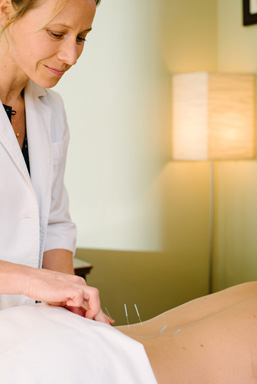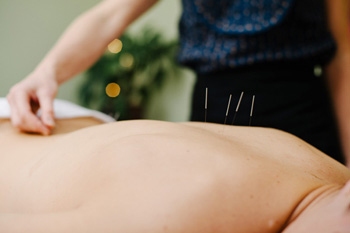Healing & Wholeness

Healing & Wholeness
Acupuncture stimulates the body’s internal resources with the insertion of hair-thin, disposable needles at specific acupoints on or near the surface of the skin. This stimulation activates the body’s own natural mechanisms to engage in a healing response, assisting it to restore normal health.
 How it works; the Western perspective
How it works; the Western perspective
Acupuncture theories today, are based on extensive laboratory and clinical research. Acupuncture is the stimulation of specific points located near or on the surface of the skin, which have the ability to alter various biochemical and physiological conditions in order to achieve the desired effect. These points are areas of designated electrical sensitivity3. The insertion of thin acupuncture needles at these points stimulates various sensory receptors that, in turn, triggers a spinal signal transmission to the hypothalamic-pituitary system at the base of the brain. The hypothalamus-pituitary glands are responsible for releasing neurotransmitters and endorphins, the body’s natural pain-killing hormones1,2,3. It is estimated that endorphins are 200 times more potent than morphine.
In addition, the pituitary gland secretes nine major hormones, which help to control a number of important body processes. These processes include growth, blood pressure, aspects of pregnancy and childbirth, sex organ function, thyroid function, metabolism, water regulation, temperature regulation and pain relief. Because Acupuncture communicates directly with the nervous system, it is able to treat back pain and arthritis as well as PMS, infertility and high blood pressure, to name a few.
The biochemicals released as a result of acupuncture not only relax the body; they help to regulate serotonin in the brain. Serotonin plays a large role in mood and disposition, which is why stress and depression are often treated with acupuncture4. Additional physiological effects of acupuncture that are observed throughout the body include increased circulation, decreased inflammation, relief from pain, relief of muscle spasms and increased T-cell count, which stimulates the immune system.
Chinese Medical Acupuncture Philosophy
Acupuncture is a holistic approach to disease management and wellness based on a 2500- year history. The principal aim of acupuncture is to restore and maintain equilibrium between a patient’s physical, emotional and spiritual aspects. The basic premise of Traditional Chinese Medicine is that health is dependent on the body’s “vital energy” known as qi, flowing in a smooth and balanced way through the body. Like a garden is irrigated by water, our bodies are nourished by qi and blood. A network of channels (meridians), are responsible for connecting qi and blood to all major organs and to acupuncture points on the skin’s surface. There are two equal and opposing forces of nature, known as Yin and Yang, which interact to regulate the flow of qi. Yin and Yang are terms used to describe the opposing nature of things, that when out of balance, create disease and when in balance result in health, such as heat vs. cold or dryness vs. phlegm. When Yin and Yang fall out of balance, qi is disturbed and illness and disease result. Just as gates or valves regulate irrigation, acupuncture points regulate our qi and blood flow. By adjusting these points an acupuncturist influences the flow of energy, blood, food, wastes, hormones, and other fluids, bringing the body into balance.
1 Ji-Sheng Han, “Acupuncture and Endorphins,” Neuroscience Letters, Vol. 361, Issue 1: 258-261, (accessed 6/11/14); available from http://www.sciencedirect.com/science/article/pii/S0304394003014009.
2 J S Han, and L Terenius, “Neurochemical Basis of Acupuncture and Analgesia,” Annual Review of Pharmacology and Toxicology, Vol. 22 (4/1982): 193-220, (accessed 6/11/2014); available from http://www.annualreviews.org/doi/abs/10.1146/annurev.pa.22.040182.001205?journalCode=pharmtox.
3 Shu-Ming Wang, Zeev N. Kain and Paul White, “Acupuncture Analgesia: I. The Scientific Basis,” Anesthesia & Analgesia, Vol.106, Issue 2 (2/2008): 602-610, (accessed 6/11/2014); available from http://journals.lww.com/anesthesia-analgesia/Fulltext/2008/02000/Acupuncture_Analgesia__I__The_Scientific_Basis.38.aspx.
4 K Yoshimoto, et al., “Acupuncture Stimulates the Release of Serotonin, but not Dopamine, in the Rat Nucleus Accumbens,” The Tohoku Journal of Experimental Medicine, Vol. 208, Issue 4 (4/2006): 321-326, (accessed 6/11/14); available from http://www.ncbi.nlm.nih.gov/pubmed/16565594.